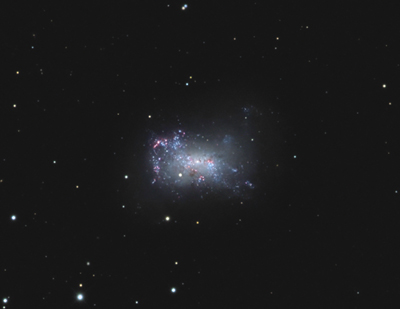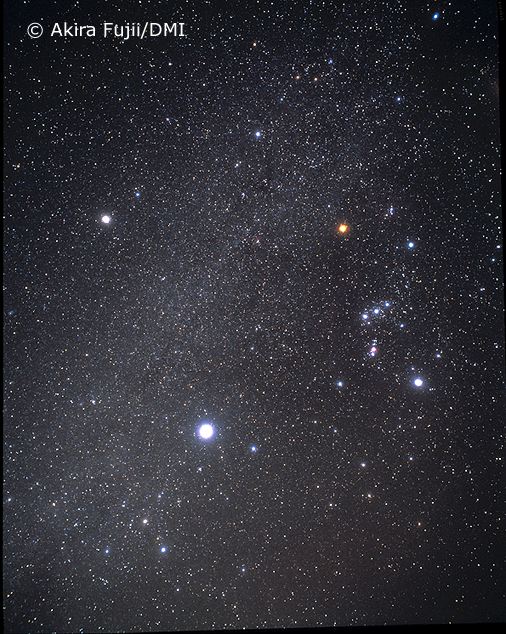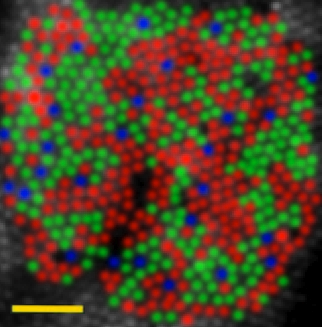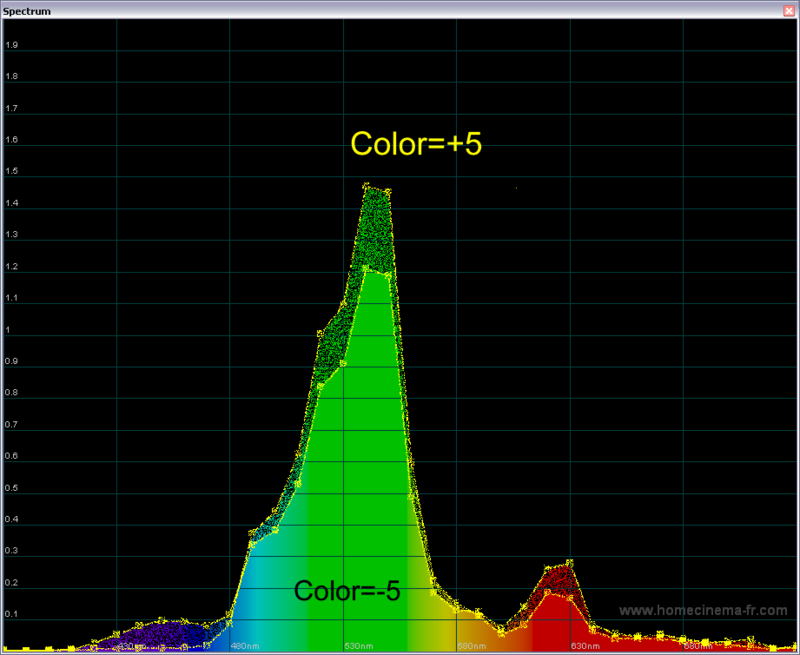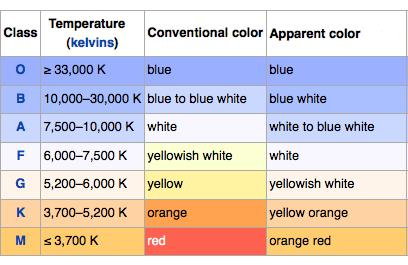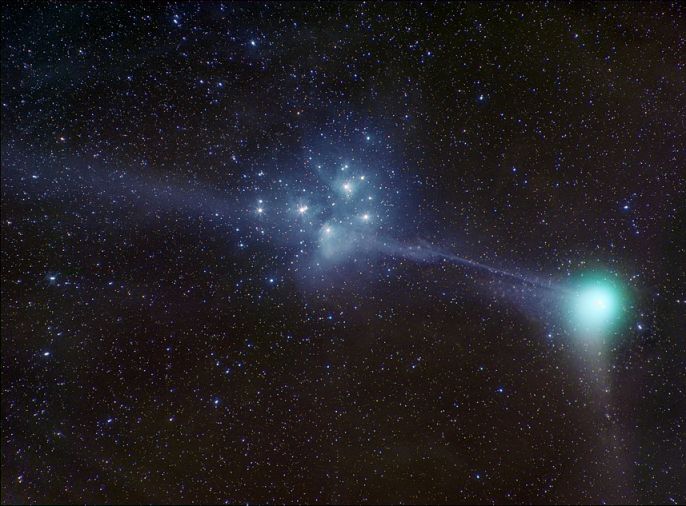M86, Pollux-colored, with a B-V color index of 0.93. Credit: David W. Hogg, Michael R. Blanton, and the Sloan Digital Sky Survey Collaboration
NGC 4449, Procyon-colored, with a B-V color index of 0.41. Credit: Michael A. Siniscalchi
But if "red" galaxies are red because they are the color of Pollux, and "blue" galaxies are blue because they are the color of Procyon, then what color are Pollux and Procyon "really" in themselves? Here is an annotated image of the so called Winter Hexagon, where you can compare Pollux and Procyon:
Credit: Jimmy Westlake.
Neither Pollux or Procyon is strongly colored in this image. In fact, there is hardly any difference in color between them here at all.
Let's try again. Follow this link, http://apod.nasa.gov/apod/ap030404.html, and you will come to another annotated picture of the Winter Hexagon. (Slide your cursor over the image and and it becomes annotated.) You can enlarge the picture and take a good look at (now not annotated) Pollux and Procyon. Here the color difference is noticeable.
But even if Pollux and Procyon are different colors, Pollux isn't very red as stars go, and Procyon isn't very blue as stars go. In fact, there is fairly general agreement that Procyon isn't blue at all, but rather yellow-white. One of those who make that claim about the color of Procyon is Professor Jamie Love in his course, "Color Designation and the Hertzsprung-Russell Diagram":
http://www.synapses.co.uk/astro/hrdiag.htmlF-type stars are fairly hot and yellowish-white. Procyon (in CANIS MINOR) is a good, bright, F5-type star.
Professor Emeritus Jim Kaler agrees with Professor Love that F stars are yellow-white. On this highly interesting page, http://stars.astro.illinois.edu/sow/class.html, Jim Kaler lists and describes stars of spectral classes O, B, A, F, G, K and M, and the OBAFGKM letters are colored according to the conventionally accepted color of the stars belonging to each spectral class. The letter F is yellow-white.
Wikipedia (http://en.wikipedia.org/wiki/Stellar_classification) also notes that F stars are conventionally described as yellow-white:
Why is there such universal agreement that F stars are a bit yellow? It could be because they really are yellow, or it could be because observers of the sky "have been led to believe" in the yellowness of this kind of stars. As for Procyon itself, it has always been the canonical, prototypical F star, in that it is bright and far enough to the north to be visible to everyone in the Northern hemisphere, where most modern astronomers and generally most people belonging to the western civilization have traditionally lived. Brilliant Canopus, by contrast, is so far to the south that it is only just visible to people in the southern states of the United States, and even then Canopus is so close to the horizon that isn't suitable for color assessment. As for Procyon, its proximity to other bright stars, and its color compared to them, makes it easy to think of Procyon as yellow-white. Take a look at this Akira Fuji picture of the "Winter Triangle", made up of bright stars Sirius, Betelgeuse and Procyon:According to informal tradition, O stars are called "blue", B "blue-white", A stars "white", F stars "yellow-white", G stars "yellow", K stars "orange", and M stars "red", even though the actual star colors perceived by an observer may deviate from these colors depending on visual conditions and individual stars observed.
In this picture, the reddish color of Betelgeuse is very striking, but careful inspection also makes it clear that Procyon is another color than brilliant Sirius and the blue-white stars of Orion. And if Procyon is neither brilliantly blue-white like Sirius nor strikingly reddish like Betelgeuse, doesn't that almost per definition make it yellow-white?
But if Procyon is yellow-white, and "blue" galaxies are typically Procyon-colored, doesn't that mean that "blue" galaxies just don't exist? Aren't they all yellow?
Or are our eyes deceiving us? Or our minds?
Both, I think. And there are two ways our eyes are deceiving us. The first one is that color response of the human retina is not the same at night, when illumination is very faint, as it is during broad daylight. Our blue-sensitive rods simply need a lot of illumination to respond, and this is in short supply when we observe the night-time sky. A reason for the poor performance of our "blue cones" is that there simply are so few of them. http://hyperphysics.phy-astr.gsu.edu/hb ... dcone.html writes:
The "blue" cones are identified by the peak of their light response curve at about 445 nm. They are unique among the cones in that they constitute only about 2% of the total number and are found outside the fovea centralis where the green and red cones are concentrated. Although they are much more light sensitive than the green and red cones, it is not enough to overcome their disadvantage in numbers.
Here is a picture showing the scarcity of blue cones compared with the number of red and green cones:
Source: http://www.kybervision.com/Blog/files/A ... splay.html
As for our relative insensitivity to blue light when it comes to stimulating color response in our eyes, http://www.visualexpert.com/Resources/nightvision.html adds:
During photopic (cone) vision, viewers are most sensitive to light that appears greenish-yellow. In scotopic vision, they are most sensitive to light which would appear greenish-blue during the day. (Of course, viewers can't actually see color in scotopic vision. It is incorrect to say that "people are most sensitive to blue light at night.")
Quite simply, we are bad at detecting blue color in very faint light sources, but we do considerably better at detecting very faint yellow color. Almost certainly, this means that when it comes to whitish stars, we will more easily see them as yellow than we will see them as blue.
But, if our night vision is fairly good at detecting yellow-green color, why don't we ever see stars as greenish? I think Henning Makholm, a science officer here at Starship Asterisk now MIA, once pointed out that since green is a primary color for humans, we won't see light as green unless it has a strong peak in the middle of the visual spectrum, in the general vicinity of 550 nm. But stars don't have strong emission lines or other other peaks in that part of the spectrum, so we don't see stars as green.
A green peak spectrum, but stars don't have sprectra like that. I found the spectrum at http://www.avsforum.com/avs-vb/showthread.php?t=852536.
Not only stars are non-green to human eyes, but the same thing goes for almost all other sky phenomena except certain forms of aurorae.
Credit: Mike Krzywonski
In the same way that we don't see stars as green, we don't see the twilight sky as green, either. This particular sky does perhaps show a hint of green, but only a hint of it.
So in short, our night-time color vision makes us see stars as yellower than they would appear to us if we could see their light magnified by many orders of magnitude and projected onto a white paper.
The is another reason why we see objects beyond the Earth's atmosphere as yellower (or redder) than they really are. The reason is, simply, the Earth's atmosphere, which scatters away some of the blue light from the original light source, making the light source look yellower (or redder) than it really is.
Credit: Olga Lipatova
A brilliantly yellow sunflower is seen against the Earth's blue sky. The sky is blue because some of the Sun's blue light has been scattered away from it and refracted all over the daytime sky, making the Sun look yellower than it would from above the atmosphere. Of course, even from our vantage point the Sun is nowhere near as yellow as that sunflower.
Isn't it odd, by the way, that most people so easily accept the idea that the Sun is yellow, but often find it strange that the sky is blue?
Why is the sky blue?, published by Ladybird Books in Australia and illustrated by Amy Schimler. There doesn't seem to be a book for children explaining why the Sun is thought of as yellow. But as I googled the question, "Why is the sun yellow?", I got this illustration instead: Sun yellow.

By the way, why does the Moon look so white in our skies? Particularly in view of the fact that in itself, the Moon really isn't white at all?
I found this image at http://www.astrobio.net/index.php?optio ... il&id=2507, and the caption to the image read: During its flight, the Galileo spacecraft returned images of the Earth and the Moon. The separate images were combined to generate this view. Credit: NASA
As you can see from this image, the Moon is much darker than the Earth, and it is rather brownish in color.
Here is another NASA image of the Earth and the Moon, where the Moon has been artificially brightened. Here the Moon looks almost yellow in color.

A brown or yellowish object will reflect red and yellow light better than it reflects blue light, so if the Moon reflects the light of the Sun, then the Moon ought to look yellower than the Sun. And it does, too. Moonlight is really yellower than sunlight. And yet most people are convinced that the Moon is whiter than the Sun. When I googled "silver moon, golden sun" I got almost two million hits, and I found this embroidered golden sun and silver moon that you can order online from something called Etsy:
Why do most people think of the Sun as yellow and the Moon as white? I'd say it's because we can't see the color of the Sun when it is high in the sky, because when the Sun is high in the sky it is quite literally blinding if you look directly at it. So don't. But even though we can't look directly at it, we "know" that it is yellow, so we continue to think of it as a source of yellow light high in the sky.
But we can look directly at the Moon when it is high in the sky, and we can plainly see that it looks very white. So we look at the high noon Sun with our mind's eye and see in our minds that it is yellow, but we look at the Moon with our real eyes and see that the Moon is white. It seems strikingly white to many of us probably because we compare it with the yellow color that we think is there in the noon-time Sun.
The Moon looks very white. But because the Moon is a dark brownish "mirror" that reflects yellow light better than it reflects blue light, it follows that moonlight is yellower than sunlight, and sunlight is whiter than moonlight. Credit: Joe Rainbow, UK.
The Moon is very bright, even though it isn't blinding, and it looks very white to us. But when it comes to objects that are very faint, our eyes are better at detecting yellow than blue color. And because the stars are quite faint, since they are so unimaginably far away, we are naturally better at detecting the yellow color they emit than we are at picking up their blue wavelenghts. But even if we were just as good at detecting blue color as yellow color in very faint light sources, we still wouldn't see the color of the stars as they really are, because all the stars that we can see in the sky have had their colors reddened by the Earth's atmosphere. Add to that that no blue stars have colors that are really saturated in the first place, it is no wonder that most people haven't seen blue color in any stars. (Though I have to say that on one occasion when I observed Lambda Orionis, Meissa, it was quite amazingly blue.)
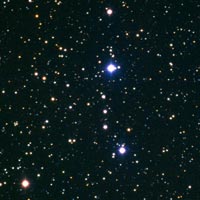
Lambda Orionis, an amzingly blue star. Information about the image can be found here: http://www.epsilon-lyrae.de/Doppelstern ... is800.html
But expectation also "colors" what hues we see in stars. Children are "told" that the Sun is yellow and generally accept it without asking why that is so. Almost all of us have also been "told" that stars are white, except some stars which are red or yellow. Because this "truth" is so universally accepted and so rarely challenged, it is hard not to "look at the stars with our mind's eye" and see them as we have been told that they look. In his book "A View of the Universe", David Malin makes this (slightly exaggerated) claim:
It isn't true that no-one had ever described even a single star as blue in ancient times. The Wikipedia article about Sirius, http://en.wikipedia.org/wiki/Sirius, notes that at least two observers in antiquity detected blue color in Sirius:After centuries of sky-watching with the unaided eye, no-one had ever described the stars as other than white, yellow or reddish-orange. Some blue stars were known from telescope observations, but they were always members of strongly colored pairs and were therefore a curiosity.
So it isn't true that no-one had ever described Sirius as blue, but David Malin is right, nevertheless, that the conventional description of the color of stars leads many people to believe that stars are yellower or redder than they really are. Today it is widely accepted that O and B stars are blue, but we are still being told that F stars are yellow-white and that M stars are red. This chart compares these so-called "conventional colors", those we are told that we should see, with the "apparent colors" of stars of various spectral classes.The 1st century AD poet Marcus Manilius described it as "sea-blue", as did the 4th century Avienus.
Conventional colors and apparent colors. Source: http://en.wikipedia.org/wiki/Stellar_classification.
Wikipedia says this about the apparent color of stars:
As can be seen from the chart, the conventional color of stars are systematically redder than the apparent colors of stars. This is another way of saying that our minds are telling our eyes to see the color of the stars as redder than they really are.The Apparent color descriptions is what the observer would see if trying to describe the stars under a dark sky without aid to the eye, or with binoculars. The table colors used are D65 standard colors, which is what you would see if the star light would be intensely magnified and projected onto a white paper, then observed in ordinary daylight.
One point that may be noted from the chart is that stars of spectral class A are conventionally described as white, and bright bluish A star Vega has become the standard of stellar whiteness. This has shifted the idea of stellar whiteness into the blue part of the spectrum, so that our Sun is described as yellow. Wikipedia says this about the color of the Sun:
http://en.wikipedia.org/wiki/Stellar_classificationOur Sun itself is white. It is sometimes called a yellow star (spectroscopically, relative to Vega), and may appear yellow or red (viewed through the atmosphere), or appear white (viewed when too bright for the eye to see any color). Astronomy images often use a variety of exaggerated colors (partially founded in faint light conditions observations, partially in conventions). But the Sun's own intrinsic color is white (aside from sunspots), with no trace of color, and closely approximates a black body of 5780 K (see color temperature). This is a natural consequence of the evolution of our optical senses: the response curve that maximizes the overall efficiency against solar illumination will by definition perceive the Sun as white.
So there is nothing magical about the Sun being white, but simply a natural consequence of human evolution and adaptation to living conditions on the Earth.
The fact that the Sun is white means, basically, that humans see daylight, which is sunlight, as white. Of course, the color of daylight changes during the day.
Top: Noon. Bottom: Late afternoon. Credit: © 2009 Bruce MacEvoy
Colors correspond to color temperature. Wikipedia (http://en.wikipedia.org/wiki/Color_temperature) writes this about color temperature:
Color temperature is a characteristic of visible light that has important applications in lighting, photography, videography, publishing, manufacturing, astrophysics, and other fields. The color temperature of a light source is the temperature of an ideal black-body radiator that radiates light of comparable hue to that of the light source.
This chart shows how color corresponds to temperature:
Source: http://www.bravolight.com/LED-Technical.html. This page notes, among other things, this about the color temperature of the Sun:
Source: http://www.bravolight.com/LED-Technical.htmlThe sun, for example, rises at approximately 1800 Kelvin and changes from red to orange to yellow and to white as it rises to over 5000 Kelvin at high noon. It then goes back down the scale as it sets.
As you can see from the color temperature chart, 5,000 Kelvin corresponds to a white color. Note, too, that the Earth's blue sky corresponds to a color temperature of about 8,500 Kelvin. Obviously this doesn't mean that the atmosphere of the Earth is really 8,500 degrees Kelvin, but its blue color corresponds to a star whose light-emitting photosphere is that hot.
And what about Vega, the stellar standard of whiteness? Professor emeritus Jim Kaler says about Vega that
Source: http://stars.astro.illinois.edu/sow/vega.html(i)ts white color and apparent brightness made it a basic standard against which the apparent magnitudes of other stars are compared.
But Jim Kaler also notes that Vega's average effective temperature is about 9,500 Kelvin. Note that this temperature, 9,500 Kelvin, is "off the color-temperature chart", and that it undoubtedly represents a color that is even bluer than the bluest temperature on that chart, which is 9,000 degrees Kelvin. So is Vega a white star? Clearly not.
What about Procyon? Jim Kaler says that its surface temperature is about 6530 Kelvin. Look at the chart again. 6,500 Kelvin represents a color that is pale blue. So if the light of Procyon was intensely magnified and projected onto a white paper and observed during daylight conditions, that is what its color would look like. Pale blue. And that is the color of Procyon.
What about the color of Pollux, the red giant star whose B-V color is typical of elliptical galaxies that stopped forming stars long ago? How red is Pollux, and how red are those elliptical galaxies? Jim Kaler says that Pollux is orange-colored and that its temperature is 4770 Kelvin. What color does that temperature correspond to?
Look at the color temperature chart again. According to the chart, 4,500 Kelvin (let alone 4,770 Kelvin) corresponds to such a pale yellow hue that it is almost indistinguishable from white.
What would the colors of Pollux and Procyon look to us in real life, if we could see their colors up close and personal, so to speak?
Suppose that Procyon and not dear old Sol was our sun. That would lead to some very radical changes for us, as you can see if you follow this link: http://www.madsci.org/posts/archives/19 ... .As.r.html. To summarize what the article says, if we orbited a 1.5 solar mass star, our sun would be six times brighter, so that, in order for us to be at a comfortable distance from it, the Earth would have to move 2.5 times farther away and orbit in the middle of the asteroid belt.
And of course this 1.5 solar mass sun would be bluer than our Sun, too. According to the link above,
A book I used to have but have mislaid, an edition of William J. Kaufmann's Universe, described the color change that would come from a 1.5 solar mass Sun in more detail. Quoting from memory, I'm sure that Kaufmann said that this 1.5 solar mass Sun would seem to be blue-white in color even when seen through the Earth's atmosphere, and the color of the sky would be much more intensely blue than today. Perhaps the sky (and the clouds) would look like this:the color spectrum of light would also shift, with the peak moving from the Sun's yellow all the way into the violet-ultraviolet range
Credit: souslesdents, http://www.flickr.com/photos/misslove/f ... 1/?view=sm.
Let's return to Pollux. We can try to understand Pollux by comparing it to various kinds of lamps and light fixtures, because lamps almost always produce a redder light than the Sun, at least if the lamps are widely used for indoor illumination.
 Lamplight, daylight. Credit: John Cooper.
Lamplight, daylight. Credit: John Cooper.Lamps usually shine redder than daylight, and redder than the Sun. Most people take it for granted that their indoor illumination will be cosy and yellow:
Albert Collings, Daylight and Lamplight.
But if we had a lamp with the color of Pollux, most of us would find its light icy blue. Not because the light of Pollux would look blue if we could magnify it intensely and project it onto a white paper and observe it during daylight conditions. No, it would look icy blue to us if it was emitted by an indoor lamp, because few of us are used to lamps that are non-yellow.
The lamp on the right is a daylight fluorescent 5000k bulb, representing a cooler temperature than the Sun. It sure looks blue here, though. The lamp on the left is a normal incandescent light bulb.
Copyright © 2011 Billet Grilles, Mesh Grilles
The long and short of it is that Procyon and Pollux are both quite pale in color and not far from the white of the Sun. Both of them are also bluer than most of us realize. But because we view them through the Earth's atmosphere they are reddened by our atmosphere, and our eyes, which are better at detecting yellow color than blue color in faint light sources, also trick us into thinking that Procyon and Pollux are redder than they really are. For the same reason we are led to believe that the Sun is yellow.
Finally, what about the "blue" and the "red" galaxies? Are they blue and red for real? I would definitely say that, yes, the Procyon-colored star-forming galaxies are indeed blue. The "red" galaxies are not as red as we usually think, however. But, as David Malin noted, when he photographed a galaxy that had the same B-V index as a K-type star, the galaxy always came out yellower than the star. So it seems safe to say that non-starforming elliptical galaxies are yellow, although they are not red. There is no such thing as a red galaxy, David Malin wrote to me once upon a time!
Finally, when I have talked about color here, I have basically talked about B-V indexes and the kind of color temperatures that we can detect with our eyes. Both stars and galaxies obviously emit light and energy at many other wavelengths too, so clearly there is more to color in cosmic objects than meets the eye!
Ann

